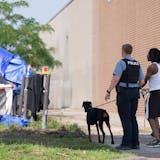Carmen Arett’s house on 17th Avenue S. in Minneapolis caught fire last summer while she was sleeping.
By the time Arett woke up, flames were licking up the side of the house and poking through the roof. She heard a loud bang, and then the wall was engulfed. She and her roommate, mother and dog all got out, but her house of 26 years was destroyed, along with the house next door. It had been a dry summer, and the inferno spread “fast and furious,” Arett said.
Officials deemed the fire an arson. But 10 months later, the case remains unsolved, with no suspects, no arrests — and not much hope for Arett, who has since moved out of town, frustrated after her boarded-up house was repeatedly broken into and her remaining belongings vandalized.
Her case is not unique; in recent years, the vast majority of arsons have gone unsolved in Minneapolis.
A Star Tribune review of Minneapolis police data found that in 2022, 104 fires were deemed arson, leading to five arrests and four suspects charged. In 2023 there were 134 arsons, 10 arrests and three suspects charged. One reason: For months during that period, the Minneapolis Police Department did not have an arson investigator.
Staffing is a big part of why most arsons go unsolved, said Brian Feintech, spokesperson for the city’s Office of Community Safety. The Minneapolis Fire Department has four investigators who determine whether suspicious fires can be called arsons. The cases are then sent to the police department, which has just one investigator to find who might be responsible.
The current MPD arson investigator was hired last spring after an eight- or nine-month period when the position sat vacant, said Feintech. “A lot of things are like that. Either nobody wants that job, or there are certain qualifications you have to have,” he said. “For a good portion of 2022 and early 2023, there was no MPD arson investigator.”
The Minneapolis Police Department has seen a significant decline in staffing overall in recent years. Last month, the MPD had 560 sworn staff with 21 on long-term leave — down 40% compared to 2020.

